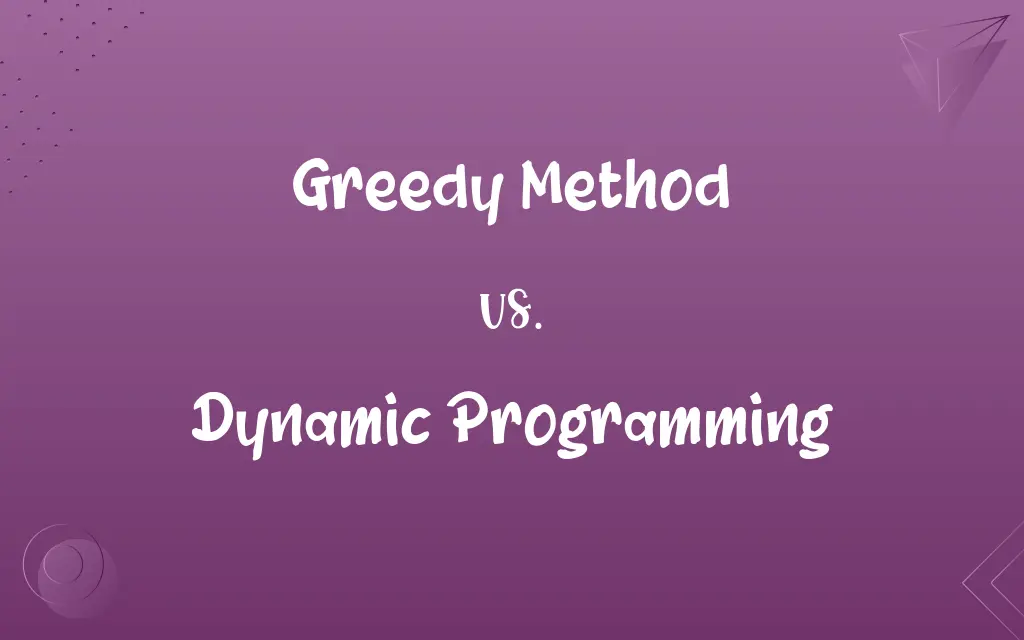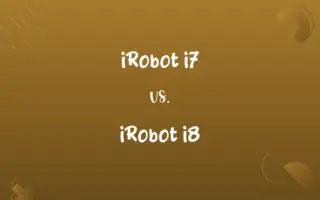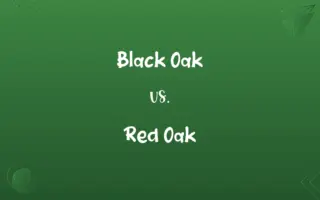Greedy Method vs. Dynamic Programming: Know the Difference

By Shumaila Saeed || Published on February 22, 2024
The Greedy Method makes the optimal choice at each step, while Dynamic Programming breaks problems into subproblems and reuses solutions.

Key Differences
The Greedy Method is an approach in algorithm design that makes the locally optimal choice at each step with the hope of finding the global optimum. Dynamic Programming, on the other hand, involves solving complex problems by breaking them down into simpler subproblems and storing the results of these subproblems to avoid redundant calculations.
Shumaila Saeed
Feb 22, 2024
Greedy algorithms are typically easier to conceptualize and can be faster because they make decisions based on local optimization. However, they may not always yield the globally optimal solution. Dynamic Programming ensures an optimal solution by considering all possible paths, but it requires more memory and computational power.
Shumaila Saeed
Feb 22, 2024
When applying the Greedy Method, the decision at each step doesn’t consider the future consequences and thus can be less efficient for some problems. In contrast, Dynamic Programming looks at the problem holistically, solving and combining the solutions of subproblems, which can be more efficient in terms of the overall solution.
Shumaila Saeed
Feb 22, 2024
The Greedy Method is often used in problems like fractional knapsack or finding the shortest path in a graph, where making the locally optimal choice also leads to a global optimum. Dynamic Programming is used in more complex problems like the knapsack problem, matrix chain multiplication, or shortest path in certain types of graphs where a global view is necessary.
Shumaila Saeed
Feb 22, 2024
Greedy algorithms are generally easier to write and more intuitive. They work well for problems like minimum spanning trees (Prim's or Kruskal's algorithms). Dynamic Programming is more suited for problems with overlapping subproblems and optimal substructure, like the Fibonacci sequence or the coin change problem.
Shumaila Saeed
Feb 22, 2024
ADVERTISEMENT
Comparison Chart
Problem Approach
Makes locally optimal choices.
Breaks down into subproblems.
Shumaila Saeed
Feb 22, 2024
Problem Suitability
Used for simpler, straightforward tasks.
Suited for complex, overlapping tasks.
Shumaila Saeed
Feb 22, 2024
ADVERTISEMENT
Greedy Method and Dynamic Programming Definitions
Greedy Method
Greedy Method does not revisit choices.
Selecting activities based on earliest finish time in activity selection.
Shumaila Saeed
Jan 23, 2024
Dynamic Programming
Dynamic Programming solves problems by breaking them into subproblems.
Calculating Fibonacci numbers by storing previously calculated values.
Shumaila Saeed
Jan 23, 2024
Greedy Method
Greedy Method makes the best choice at the current moment.
Finding the largest coin possible in each step for making change.
Shumaila Saeed
Jan 23, 2024
Dynamic Programming
Dynamic Programming is used for optimization problems.
Maximizing the value of a knapsack in the knapsack problem.
Shumaila Saeed
Jan 23, 2024
Greedy Method
Greedy algorithms aim for local optimization.
Choosing the nearest city next in the traveling salesman problem.
Shumaila Saeed
Jan 23, 2024
ADVERTISEMENT
Dynamic Programming
Dynamic Programming applies when subproblems overlap.
Minimizing the number of coins needed for change.
Shumaila Saeed
Jan 23, 2024
Greedy Method
Greedy algorithms are simple and straightforward.
Using Huffman coding for data compression.
Shumaila Saeed
Jan 23, 2024
Dynamic Programming
Dynamic Programming uses memorization or tabulation.
Finding the shortest path in a grid with dynamic programming.
Shumaila Saeed
Jan 23, 2024
Greedy Method
Greedy Method is used where immediate decisions are optimal.
Building a spanning tree with the minimum edge weight first.
Shumaila Saeed
Jan 23, 2024
Dynamic Programming
Dynamic Programming combines solutions of subproblems.
Determining the optimal way to multiply matrices.
Shumaila Saeed
Jan 23, 2024
Repeatedly Asked Queries
What is the Greedy Method in simple terms?
It’s an algorithmic approach that makes the best immediate choice at each step.
Shumaila Saeed
Feb 22, 2024
Can Greedy Method always guarantee an optimal solution?
No, it’s not always optimal for all problems.
Shumaila Saeed
Feb 22, 2024
What is a common use of the Greedy Method?
It's often used in routing and network algorithms.
Shumaila Saeed
Feb 22, 2024
How does Dynamic Programming ensure optimality?
By considering all possible solutions through subproblems.
Shumaila Saeed
Feb 22, 2024
Is the Greedy Method fast?
Yes, it's generally faster due to its straightforward approach.
Shumaila Saeed
Feb 22, 2024
What is Dynamic Programming?
It’s a method for solving complex problems by breaking them into smaller subproblems.
Shumaila Saeed
Feb 22, 2024
Is Dynamic Programming memory-intensive?
Yes, it can be, due to storing solutions of subproblems.
Shumaila Saeed
Feb 22, 2024
Are Greedy algorithms easy to implement?
Generally yes, due to their straightforward nature.
Shumaila Saeed
Feb 22, 2024
Do Greedy algorithms work well for all graph problems?
No, they are not suitable for problems requiring global information.
Shumaila Saeed
Feb 22, 2024
Can Dynamic Programming be used in real-time systems?
It can be challenging due to its computational and memory requirements.
Shumaila Saeed
Feb 22, 2024
What is an example of a Greedy algorithm?
Kruskal’s algorithm for minimum spanning trees.
Shumaila Saeed
Feb 22, 2024
Give an example of Dynamic Programming.
The Bellman-Ford algorithm for shortest paths.
Shumaila Saeed
Feb 22, 2024
What is a key feature of Dynamic Programming?
Its use of memorization or tabulation to store subproblem solutions.
Shumaila Saeed
Feb 22, 2024
Is Greedy Method suitable for complex sequential decisions?
Not typically, as it doesn’t consider future consequences.
Shumaila Saeed
Feb 22, 2024
How does Dynamic Programming approach decision making?
By evaluating the consequences of future actions.
Shumaila Saeed
Feb 22, 2024
Where is Dynamic Programming commonly used?
In optimization problems and complex calculations.
Shumaila Saeed
Feb 22, 2024
Can Dynamic Programming be overkill for simple problems?
Yes, for simple problems, simpler algorithms can be more efficient.
Shumaila Saeed
Feb 22, 2024
Is Greedy Method or Dynamic Programming better for large data sets?
Dynamic Programming is often better for larger, more complex data sets.
Shumaila Saeed
Feb 22, 2024
Are there problems unsolvable by Greedy Method but solvable by Dynamic Programming?
Yes, like certain types of shortest path problems.
Shumaila Saeed
Feb 22, 2024
What’s easier to understand, Greedy Method or Dynamic Programming?
Greedy Method is generally easier due to its simpler logic.
Shumaila Saeed
Feb 22, 2024
Share this page
Link for your blog / website
HTML
Link to share via messenger
About Author
Written by
Shumaila SaeedShumaila Saeed, an expert content creator with 6 years of experience, specializes in distilling complex topics into easily digestible comparisons, shining a light on the nuances that both inform and educate readers with clarity and accuracy.








































































